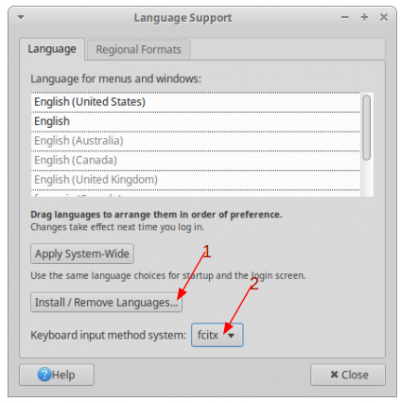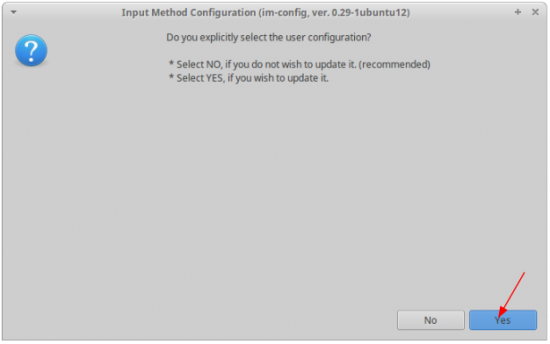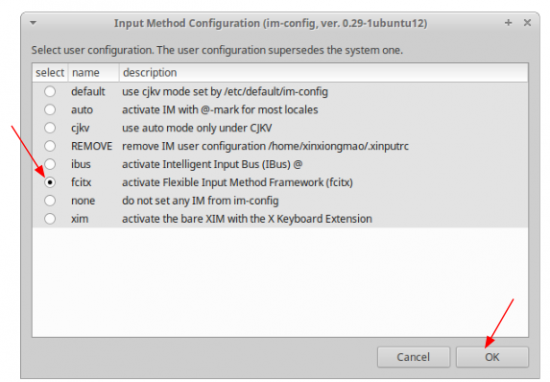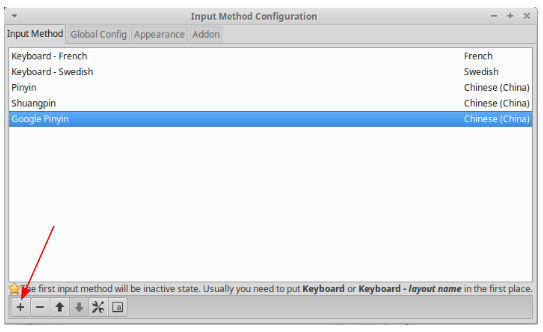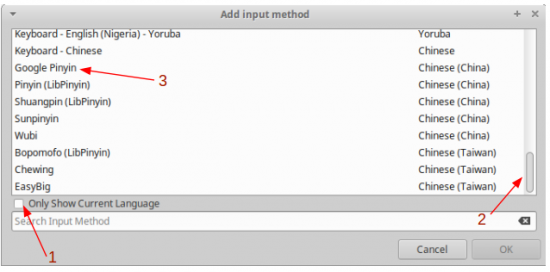Difference between revisions of "Languages"
(→Add new / manage languages (locales)) |
|||
| Line 1: | Line 1: | ||
[[Category:Linux]] | [[Category:Linux]] | ||
| − | |||
| − | |||
| − | |||
| − | |||
| − | |||
| − | |||
| + | On this page you'll find how to: | ||
| + | * Display different languages | ||
| + | * Input in different languages (chinese, swedish, french...) | ||
| − | |||
| − | |||
| − | |||
| − | |||
| − | |||
| − | |||
| − | |||
| − | |||
| − | |||
| − | == | + | =Fonts= |
| − | |||
| − | |||
| − | |||
| + | ==European / common fonts== | ||
| − | |||
<syntaxhighlight lang="bash"> | <syntaxhighlight lang="bash"> | ||
| + | apt-get install xfonts-intl-european xfonts-intl-phonetic | ||
| + | apt-get install mathematica-fonts | ||
apt-get install ttf-mscorefonts-installer | apt-get install ttf-mscorefonts-installer | ||
| + | apt-get install fontypython ttf-opensymbol | ||
</syntaxhighlight> | </syntaxhighlight> | ||
| − | == | + | ==Asian fonts== |
| + | |||
<syntaxhighlight lang="bash"> | <syntaxhighlight lang="bash"> | ||
| + | apt-get install xfonts-intl-asian xfonts-intl-chinese xfonts-intl-chinese-big | ||
| + | apt-get install pinyin-database sunpinyin-utils libpinyin-utils | ||
apt-get install fonts-arphic-ukai fonts-arphic-uming | apt-get install fonts-arphic-ukai fonts-arphic-uming | ||
apt-get install fonts-arphic-* | apt-get install fonts-arphic-* | ||
| Line 40: | Line 31: | ||
</syntaxhighlight> | </syntaxhighlight> | ||
| + | * More info on PinYin Joe: http://www.pinyinjoe.com/index.html | ||
| + | * More fonts on: http://cooltext.com/Download-Font-%E7%B2%97%E6%A5%B7%E4%BD%93%E7%AE%80+Kai+Bold | ||
| + | |||
| + | |||
| + | ==Android / Google fonts== | ||
| + | |||
| + | <syntaxhighlight lang="bash"> | ||
| + | apt-get install fonts-droid-fallback fonts-roboto fonts-roboto-hinted | ||
| + | </syntaxhighlight> | ||
| − | |||
| − | + | ==Printing fonts== | |
| − | + | Full set of printing fonts: | |
<syntaxhighlight lang="bash"> | <syntaxhighlight lang="bash"> | ||
| − | apt-get install fonts- | + | apt-get install texlive-fonts-recommended texlive-fonts-extra texlive-lang-chinese texlive-lang-french texlive-lang-english |
</syntaxhighlight> | </syntaxhighlight> | ||
| − | + | !! Warning this required about 900 Mb !! | |
| − | |||
| − | |||
| + | =Support many languages (locales)= | ||
| − | + | ==Installation== | |
<syntaxhighlight lang="bash"> | <syntaxhighlight lang="bash"> | ||
| − | apt-get install | + | apt-get install locales |
</syntaxhighlight> | </syntaxhighlight> | ||
| − | ' | + | ==Configuration (1)== |
| + | |||
| + | * Search for your language locale's String | ||
| − | |||
<syntaxhighlight lang="bash"> | <syntaxhighlight lang="bash"> | ||
| − | + | # replace FR by your own language code (zh, de, sv, ...) | |
| + | less /usr/share/i18n/SUPPORTED | grep fr | ||
</syntaxhighlight> | </syntaxhighlight> | ||
| − | + | Create / edit the configuration file | |
| + | |||
| + | <syntaxhighlight lang="bash"> | ||
| + | vim /var/lib/locales/supported.d/local | ||
| + | |||
| + | # Example of many languages combination: | ||
| + | en_US.UTF-8 UTF-8 | ||
| + | fr_FR.UTF-8 UTF-8 | ||
| + | de_DE.UTF-8 UTF-8 | ||
| + | sv_SE.UTF-8 UTF-8 | ||
| + | zh_CN.UTF-8 UTF-8 | ||
| + | </syntaxhighlight> | ||
| + | |||
| + | ==Configuration (2)== | ||
| + | Regenerate system languages | ||
| − | |||
<syntaxhighlight lang="bash"> | <syntaxhighlight lang="bash"> | ||
| − | + | dpkg-reconfigure locales | |
</syntaxhighlight> | </syntaxhighlight> | ||
| − | + | ||
| + | Check result: | ||
| + | |||
<syntaxhighlight lang="bash"> | <syntaxhighlight lang="bash"> | ||
| − | + | locale -a | |
</syntaxhighlight> | </syntaxhighlight> | ||
| − | == | + | (i) '''You need to restart''' your server before using the new languages. |
| + | |||
| + | |||
| + | |||
| + | =Inputs manager= | ||
| + | |||
| + | Depending on your Linux distribution and version you might be interested by: | ||
| + | * IBUS - old input manager, still efficient. Default on most distribution until 2015 | ||
| + | * FCITX - new input manager, new standard since 2015. | ||
| + | |||
| + | |||
| + | ==FCITX (Ubuntu >= 16)== | ||
| + | |||
| + | ===Installation=== | ||
| + | |||
| + | Input methods: | ||
| + | |||
<syntaxhighlight lang="bash"> | <syntaxhighlight lang="bash"> | ||
| − | + | apt-get install fcitx | |
| + | apt-get install fcitx-libs fcitx-table-emoji fcitx-table-easy-big | ||
| + | |||
| + | # Pinyin = chinese chars. encoded in standard GB | ||
| + | # SunPinYin = OpenSource project, official pinyin support for Linux | ||
| + | # Google PinYin = Same PinYin as Android | ||
| + | # CheWing = MS Windows PinYin | ||
| + | apt-get install fcitx-pinyin fcitx-sunpinyin fcitx-googlepinyin fcitx-chewing | ||
| + | |||
| + | # Japanese input | ||
| + | apt-get install fcitx-anthy | ||
| + | |||
| + | # Display pinyin input menu (list of characters) -> qimpanel does NOT work well on XCFE. Better remove it and switch to the 'classic' UI | ||
| + | apt-get remove --purge fcitx-ui-qimpanel | ||
| + | apt-get install fcitx-ui-classic fcitx-ui-light | ||
| + | |||
| + | # Keyboard support for Mozilla Firefox and other applications | ||
| + | apt-get install fcitx-mozc | ||
</syntaxhighlight> | </syntaxhighlight> | ||
| − | + | Language selector: | |
| + | |||
| + | <syntaxhighlight lang="bash"> | ||
| + | apt-get install im-config | ||
| + | </syntaxhighlight> | ||
| − | |||
| − | |||
| + | ===FCITX as default input manager=== | ||
| − | + | '''Language support''' | |
| − | * | + | * Go to '''Preferences''' > '''Language support''' |
| + | * Install required languages (French, Chinese, English, ...) | ||
| + | * Select input method ''fcitx'' | ||
| + | [[File:Language selection 1.png|400px|Language Support]] | ||
| + | * Confirm! | ||
| − | |||
| + | '''IM-Config''' | ||
| − | + | Sometimes the 1st step is not enough. You need to run ''im-config'' as well. | |
| − | |||
<syntaxhighlight lang="bash"> | <syntaxhighlight lang="bash"> | ||
| − | + | # run as a user | |
| + | im-config | ||
</syntaxhighlight> | </syntaxhighlight> | ||
| + | * Click OK on the 1st screen | ||
| + | * Click ''YES'' on the 2nd screen to explicitly set the language input manager | ||
| + | |||
| + | [[File:Language selection 2.png|550px|IM-Config #1]] | ||
| + | |||
| + | * Choose FCITX on the new screen and valid | ||
| + | |||
| + | [[File:Language selection 3.png|550px|IM-Config #2]] | ||
| + | |||
| + | * Confirm! | ||
| + | |||
| + | |||
| + | '''Remove conflict''' | ||
| + | |||
| + | Run the next step before you log-off / log-in and use FCITX as your default input manager. | ||
| + | There is a bug in the default configuration that prevent the display of PinYin characters table. | ||
| − | |||
| − | + | ||
| + | ===BugFix: PinYin table doesn't appear=== | ||
| + | |||
| + | |||
| + | By default on the ''language support'' step Ubuntu force the installation of a crappy package ''fcitx-ui-qimpanel''. You must remove it: | ||
| + | |||
<syntaxhighlight lang="bash"> | <syntaxhighlight lang="bash"> | ||
| − | + | # Display pinyin input menu (list of characters) -> qimpanel does NOT work well on XCFE. Better remove it and switch to the 'classic' UI | |
| + | apt-get remove --purge fcitx-ui-qimpanel | ||
| + | apt-get install fcitx-ui-classic fcitx-ui-light | ||
</syntaxhighlight> | </syntaxhighlight> | ||
| − | + | After installation you must log-off / log-in | |
| − | |||
| − | |||
| − | |||
| − | |||
| − | |||
| + | ===Usage=== | ||
| + | Once you re-log yourself you should see a FCITX option on the toolbar (close to the clock). | ||
| + | * Click on FCITX toolbar > '''configure input method''' | ||
| + | * Add new languages and input method as follow: | ||
| + | ** Click on ADD input | ||
| − | + | [[File:Language selection 4.png|550px|FCITX config #1]] | |
| − | |||
| − | |||
| − | |||
| − | + | ** Un-tick the check box to display ALL languages ; search for the input you'd like to add. (i) Chinese input are at the bottom | |
| + | [[File:Language selection 5.png|550px|FCITX config #2]] | ||
| − | + | Done! | |
| − | |||
| − | |||
| − | + | You can use PinYin or any other input you'd like! | |
| − | |||
| − | |||
| − | |||
| − | |||
| − | |||
| − | |||
| − | + | ==Input manager IBUS (Ubuntu < 16)== | |
<syntaxhighlight lang="bash"> | <syntaxhighlight lang="bash"> | ||
| − | + | apt-get install ibus | |
</syntaxhighlight> | </syntaxhighlight> | ||
| − | + | ==Chinese PinYin== | |
| − | |||
<syntaxhighlight lang="bash"> | <syntaxhighlight lang="bash"> | ||
| − | + | apt-get install ibus-pinyin ibus-sunpinyin ibus-googlepinyin | |
</syntaxhighlight> | </syntaxhighlight> | ||
| − | + | ==Input configuration== | |
<syntaxhighlight lang="bash"> | <syntaxhighlight lang="bash"> | ||
| − | + | ibus-setup | |
| − | |||
</syntaxhighlight> | </syntaxhighlight> | ||
| + | |||
| + | |||
| + | Set Ibus as default: | ||
| + | |||
| + | * System Menu -> System Settings -> Language Support and set the "Keyboard Input Method" to "ibus" | ||
| + | * Then log out and back in again. | ||
Revision as of 17:03, 24 April 2016
On this page you'll find how to:
- Display different languages
- Input in different languages (chinese, swedish, french...)
Fonts
European / common fonts
apt-get install xfonts-intl-european xfonts-intl-phonetic
apt-get install mathematica-fonts
apt-get install ttf-mscorefonts-installer
apt-get install fontypython ttf-opensymbol
Asian fonts
apt-get install xfonts-intl-asian xfonts-intl-chinese xfonts-intl-chinese-big
apt-get install pinyin-database sunpinyin-utils libpinyin-utils
apt-get install fonts-arphic-ukai fonts-arphic-uming
apt-get install fonts-arphic-*
# See https://en.wikipedia.org/wiki/WenQuanYi
apt-get install fonts-wqy-zenhei fonts-wqy-microhei xfonts-wqy- More info on PinYin Joe: http://www.pinyinjoe.com/index.html
- More fonts on: http://cooltext.com/Download-Font-%E7%B2%97%E6%A5%B7%E4%BD%93%E7%AE%80+Kai+Bold
Android / Google fonts
apt-get install fonts-droid-fallback fonts-roboto fonts-roboto-hinted
Printing fonts
Full set of printing fonts:
apt-get install texlive-fonts-recommended texlive-fonts-extra texlive-lang-chinese texlive-lang-french texlive-lang-english!! Warning this required about 900 Mb !!
Support many languages (locales)
Installation
apt-get install locales
Configuration (1)
- Search for your language locale's String
# replace FR by your own language code (zh, de, sv, ...)
less /usr/share/i18n/SUPPORTED | grep fr
Create / edit the configuration file
vim /var/lib/locales/supported.d/local
# Example of many languages combination:
en_US.UTF-8 UTF-8
fr_FR.UTF-8 UTF-8
de_DE.UTF-8 UTF-8
sv_SE.UTF-8 UTF-8
zh_CN.UTF-8 UTF-8
Configuration (2)
Regenerate system languages
dpkg-reconfigure locales
Check result:
locale -a
(i) You need to restart your server before using the new languages.
Inputs manager
Depending on your Linux distribution and version you might be interested by:
- IBUS - old input manager, still efficient. Default on most distribution until 2015
- FCITX - new input manager, new standard since 2015.
FCITX (Ubuntu >= 16)
Installation
Input methods:
apt-get install fcitx
apt-get install fcitx-libs fcitx-table-emoji fcitx-table-easy-big
# Pinyin = chinese chars. encoded in standard GB
# SunPinYin = OpenSource project, official pinyin support for Linux
# Google PinYin = Same PinYin as Android
# CheWing = MS Windows PinYin
apt-get install fcitx-pinyin fcitx-sunpinyin fcitx-googlepinyin fcitx-chewing
# Japanese input
apt-get install fcitx-anthy
# Display pinyin input menu (list of characters) -> qimpanel does NOT work well on XCFE. Better remove it and switch to the 'classic' UI
apt-get remove --purge fcitx-ui-qimpanel
apt-get install fcitx-ui-classic fcitx-ui-light
# Keyboard support for Mozilla Firefox and other applications
apt-get install fcitx-mozc
Language selector:
apt-get install im-config
FCITX as default input manager
Language support
- Go to Preferences > Language support
- Install required languages (French, Chinese, English, ...)
- Select input method fcitx
- Confirm!
IM-Config
Sometimes the 1st step is not enough. You need to run im-config as well.
# run as a user
im-config- Click OK on the 1st screen
- Click YES on the 2nd screen to explicitly set the language input manager
- Choose FCITX on the new screen and valid
- Confirm!
Remove conflict
Run the next step before you log-off / log-in and use FCITX as your default input manager. There is a bug in the default configuration that prevent the display of PinYin characters table.
BugFix: PinYin table doesn't appear
By default on the language support step Ubuntu force the installation of a crappy package fcitx-ui-qimpanel. You must remove it:
# Display pinyin input menu (list of characters) -> qimpanel does NOT work well on XCFE. Better remove it and switch to the 'classic' UI
apt-get remove --purge fcitx-ui-qimpanel
apt-get install fcitx-ui-classic fcitx-ui-lightAfter installation you must log-off / log-in
Usage
Once you re-log yourself you should see a FCITX option on the toolbar (close to the clock).
- Click on FCITX toolbar > configure input method
- Add new languages and input method as follow:
- Click on ADD input
- Un-tick the check box to display ALL languages ; search for the input you'd like to add. (i) Chinese input are at the bottom
Done!
You can use PinYin or any other input you'd like!
Input manager IBUS (Ubuntu < 16)
apt-get install ibusChinese PinYin
apt-get install ibus-pinyin ibus-sunpinyin ibus-googlepinyin
Input configuration
ibus-setup
Set Ibus as default:
- System Menu -> System Settings -> Language Support and set the "Keyboard Input Method" to "ibus"
- Then log out and back in again.
